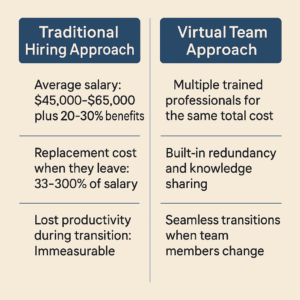5 Steps to Protect Your Business When a Star Staff Member Leaves
How to Build a Team That Can Weather Any Departure
You’ve just arrived at your vacation destination when you get the text that every small business owner dreads: “I quit.” Your key employee, the one who handles your biggest clients, knows all your processes, and basically runs half your operation, just walked away without notice.
This employee dependency crisis is more common than most business owners realize. According to Pew Research Center analysis of Census Bureau data, 49% of small business firms with employees have just one to four workers, highlighting how vulnerable these businesses are to the loss of key personnel for ensuring organizational success.
That’s exactly what happened to my husband Mark and me. We were on our first vacation in seven years from our property management business when a single text message from our most trusted employee changed everything: “I quit.” No notice. No transition plan. No backup.
The financial impact is substantial. Gallup estimates that replacing employees costs around 200% of salary for leaders and managers, 80% for technical professionals, and 40% for frontline employees.
That vacation text was our wake-up call, but you don’t have to wait for your own crisis.
Why Do Small Businesses Become Vulnerable to Employee Dependency Crisis? 
Nothing exposes business vulnerability quite like the sudden departure of a crucial employee.
Most business owners know they shouldn’t rely so heavily on individual employees, but it happens gradually. You hire someone good, they prove themselves reliable, and slowly you start giving them more responsibility. Before you know it, this person has become indispensable.
5 Warning Signs Your Business Has Dangerous Employee Dependency:
- Only one person knows how to handle your biggest client
- You can’t take vacation without constant check-ins
- Critical passwords or processes live in one person’s head
- Other employees say “Ask [Name], they handle that”
- You feel panic when that person calls in sick
Great employees often create this problem through their own competence. They’re so good at what they do that you naturally give them more responsibility. While this efficiency feels great, it creates dangerous single points of failure in your business.
What Should You Do When Your Most Important Employee Quits?
After that vacation disaster, Mark and I knew we had to rethink everything. We couldn’t build a business that depended on any single person’s loyalty or availability. We needed what I call “distributed expertise”: multiple people trained on the same critical functions.
At a mastermind event, someone mentioned offshore staffing solutions. Initially, we had typical concerns about virtual employees. Could remote team members really understand our business? Would they be reliable enough for critical functions?
But desperation has a way of opening minds to new possibilities.
We discovered something remarkable: the Philippines had a vast pool of highly educated, English-speaking professionals who could provide the same quality work at a fraction of local hiring costs. More importantly, we could build teams with overlapping skills and shared knowledge.
How Can Small Businesses Create Business Continuity Planning for Critical Roles?
Building anti-fragile operations means no single departure can derail your business. Here’s the framework we developed:
Step 1: How Do You Identify Single Points of Failure?
Audit your operations to find where critical knowledge lives in just one person’s head. This includes client relationships, specialized processes, vendor connections, and technical systems.
Step 2: Why Should You Document Everything?
Create detailed process documentation that any trained professional can follow. This captures both procedures and the reasoning behind decisions and the nuances that make processes work.
Step 3: How Do You Cross-Train Multiple Team Members Affordably?
Virtual employees make this approach financially feasible. You can afford to have multiple people trained on the same functions because the cost structure allows for redundancy without budget strain. Learning how to delegate tasks effectively is crucial for building these backup systems.
Step 4: What’s the Best Way to Build Overlapping Client Relationships?
Ensure that multiple team members interact with each important client. When knowledge and relationships are shared across several trained professionals, no single departure disrupts service.
Step 5: How Often Should You Test Your Backup Systems?
Regularly simulate departures by having backup team members handle responsibilities. This identifies gaps before they become crises.
“Chi’s contributions have been instrumental in elevating our team’s performance and creating a culture of accountability and excellence,” said one client about their HireSmart virtual employee. “When a key project faced delays, Chi stepped in to facilitate discussions, clarify objectives, and establish effective timelines.”
What’s the Real Cost of Employee Turnover vs. Building Redundant Teams?
Here’s the math that changes everything: for the cost of one highly paid local employee, you can hire multiple virtual employees with overlapping skills. You’re building depth and redundancy into your operations rather than just replacing one person with another.
When someone on our virtual team takes vacation or moves on to new opportunities, we don’t panic. Other team members already understand the processes and can seamlessly continue the work. Understanding how to improve your employee retention becomes less critical when your business doesn’t depend on any single person staying forever.
How Do You Find Reliable Employees for Small Business Continuity?
The key centers on building systems that work regardless of who operates them. Virtual employees have transformed how we think about business resilience. Because they’re cost-effective, we can afford to have multiple people trained on the same critical functions.
We’ve learned that business continuity planning focuses on building operations that thrive regardless of individual departures. When you understand what makes your next business leader emerge from within your team, you’re building sustainable growth.
 Never Again: How Can You Build Your Employee-Independent Business?
Never Again: How Can You Build Your Employee-Independent Business?
That vacation text message was the wake-up call we needed, but you don’t have to wait for your own crisis. You can build operational resilience now, before you’re forced to confront the vulnerability of single-employee dependency.
When you have multiple trained professionals who understand your operations, client relationships remain stable, projects continue moving forward, and you can actually take vacations without checking your phone every five minutes.
The goal focuses on building a business where good people can grow, contribute, and even move on without creating operational chaos. This connects directly to what I’ve shared about how employees know they’re valued because when people feel appreciated within well-structured systems, they’re more likely to give proper notice and help with transitions.
Ready to build a business that survives any resignation? Click here to schedule your free consultation about creating the operational resilience your business needs.
About the Author
Anne Lackey is the Co-Founder and CEO of HireSmart Virtual Employees, where she helps businesses scale with full-time, highly trained remote staff. With decades of experience in business operations and systems, Anne is a recognized expert in virtual staffing, process efficiency, and team building.

